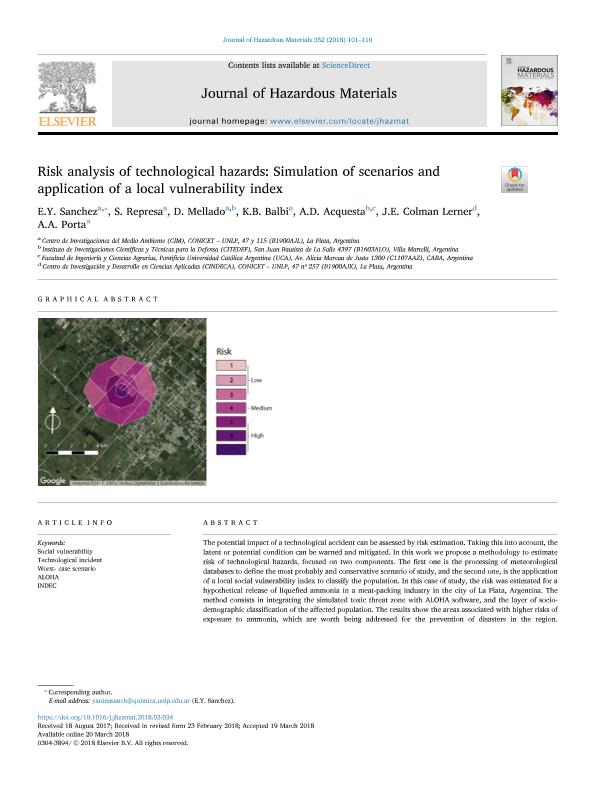Mostrar el registro sencillo del ítem
dc.contributor.author
Sánchez, Érica Yanina

dc.contributor.author
Represa, Natacha Soledad

dc.contributor.author
Mellado, Daniela

dc.contributor.author
Balbi, Karina Beatriz

dc.contributor.author
Acquesta, Alejandro Dante

dc.contributor.author
Colman Lerner, Jorge Esteban

dc.contributor.author
Porta, A.A.
dc.date.available
2020-03-17T20:15:02Z
dc.date.issued
2018-06
dc.identifier.citation
Sánchez, Érica Yanina; Represa, Natacha Soledad; Mellado, Daniela; Balbi, Karina Beatriz; Acquesta, Alejandro Dante; et al.; Risk analysis of technological hazards: Simulation of scenarios and application of a local vulnerability index; Elsevier Science; Journal of Hazardous Materials; 352; 6-2018; 101-110
dc.identifier.issn
0304-3894
dc.identifier.uri
http://hdl.handle.net/11336/99920
dc.description.abstract
The potential impact of a technological accident can be assessed by risk estimation. Taking this into account, the latent or potential condition can be warned and mitigated. In this work we propose a methodology to estimate risk of technological hazards, focused on two components. The first one is the processing of meteorological databases to define the most probably and conservative scenario of study, and the second one, is the application of a local social vulnerability index to classify the population. In this case of study, the risk was estimated for a hypothetical release of liquefied ammonia in a meat-packing industry in the city of La Plata, Argentina. The method consists in integrating the simulated toxic threat zone with ALOHA software, and the layer of sociodemographic classification of the affected population. The results show the areas associated with higher risks of exposure to ammonia, which are worth being addressed for the prevention of disasters in the region. Advantageously, this systemic approach is methodologically flexible as it provides the possibility of being applied in various scenarios based on the available information of both, the exposed population and its meteorology. Furthermore, this methodology optimizes the processing of the input data and its calculation.
dc.format
application/pdf
dc.language.iso
eng
dc.publisher
Elsevier Science

dc.rights
info:eu-repo/semantics/openAccess
dc.rights.uri
https://creativecommons.org/licenses/by-nc-sa/2.5/ar/
dc.subject
ALOHA
dc.subject
INDEC
dc.subject
SOCIAL VULNERABILITY
dc.subject
TECHNOLOGICAL INCIDENT
dc.subject
WORST- CASE SCENARIO
dc.subject.classification
Otras Ingeniería del Medio Ambiente

dc.subject.classification
Ingeniería del Medio Ambiente

dc.subject.classification
INGENIERÍAS Y TECNOLOGÍAS

dc.title
Risk analysis of technological hazards: Simulation of scenarios and application of a local vulnerability index
dc.type
info:eu-repo/semantics/article
dc.type
info:ar-repo/semantics/artículo
dc.type
info:eu-repo/semantics/publishedVersion
dc.date.updated
2020-03-12T18:46:26Z
dc.journal.volume
352
dc.journal.pagination
101-110
dc.journal.pais
Países Bajos

dc.journal.ciudad
Amsterdam
dc.description.fil
Fil: Sánchez, Érica Yanina. Universidad Nacional de La Plata. Facultad de Ciencias Exactas. Departamento de Química. Centro de Investigaciones del Medio Ambiente; Argentina. Consejo Nacional de Investigaciones Científicas y Técnicas; Argentina
dc.description.fil
Fil: Represa, Natacha Soledad. Universidad Nacional de La Plata. Facultad de Ciencias Exactas. Departamento de Química. Centro de Investigaciones del Medio Ambiente; Argentina. Consejo Nacional de Investigaciones Científicas y Técnicas; Argentina
dc.description.fil
Fil: Mellado, Daniela. Ministerio de Defensa. Instituto de Investigaciones Científicas y Técnicas para la Defensa; Argentina. Universidad Nacional de La Plata. Facultad de Ciencias Exactas. Departamento de Química. Centro de Investigaciones del Medio Ambiente; Argentina. Consejo Nacional de Investigaciones Científicas y Técnicas; Argentina
dc.description.fil
Fil: Balbi, Karina Beatriz. Universidad Nacional de La Plata. Facultad de Ciencias Exactas. Departamento de Química. Centro de Investigaciones del Medio Ambiente; Argentina
dc.description.fil
Fil: Acquesta, Alejandro Dante. Pontificia Universidad Católica Argentina "Santa María de los Buenos Aires"; Argentina. Ministerio de Defensa. Instituto de Investigaciones Científicas y Técnicas para la Defensa; Argentina. Consejo Nacional de Investigaciones Científicas y Técnicas; Argentina
dc.description.fil
Fil: Colman Lerner, Jorge Esteban. Consejo Nacional de Investigaciones Científicas y Técnicas. Centro Científico Tecnológico Conicet - La Plata. Centro de Investigación y Desarrollo en Ciencias Aplicadas "Dr. Jorge J. Ronco". Universidad Nacional de la Plata. Facultad de Ciencias Exactas. Centro de Investigación y Desarrollo en Ciencias Aplicadas; Argentina
dc.description.fil
Fil: Porta, A.A.. Universidad Nacional de La Plata. Facultad de Ciencias Exactas. Departamento de Química. Centro de Investigaciones del Medio Ambiente; Argentina
dc.journal.title
Journal of Hazardous Materials

dc.relation.alternativeid
info:eu-repo/semantics/altIdentifier/url/https://www.sciencedirect.com/science/article/abs/pii/S0304389418301869
dc.relation.alternativeid
info:eu-repo/semantics/altIdentifier/doi/http://dx.doi.org/10.1016/j.jhazmat.2018.03.034
Archivos asociados
